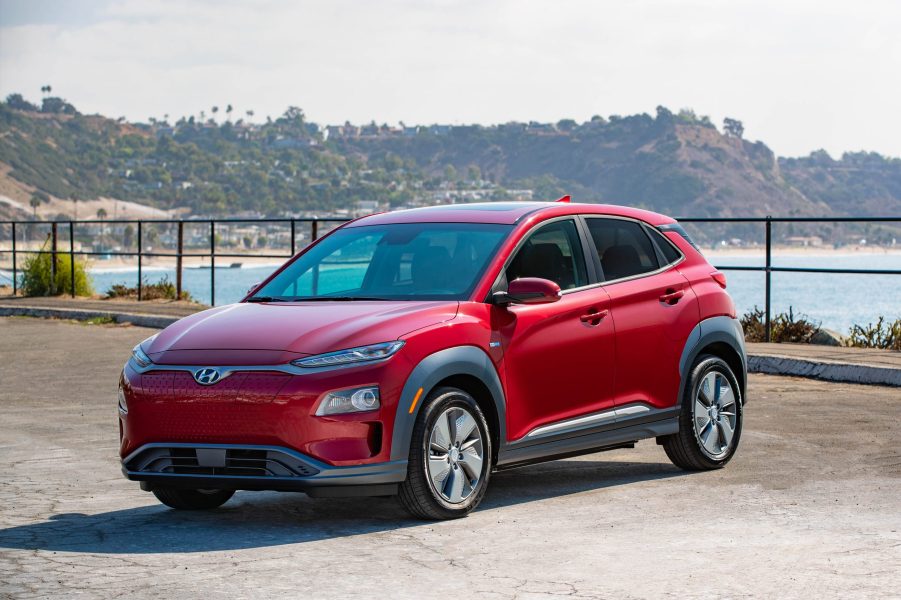
Is the Hyundai Kona Electric Better Than the Regular Kona?
With EVs gaining longer ranges and better charging options, more people are willing to consider them as family vehicles. Can the electric version of Hyundai’s Kona match the performance of the gas-powered model?Recently, the team at Motor Trend took a look at the new Hyundai Kona to determine how the electric model matches up to the gas-powered Kona.
The MotorTrend team takes a look at both. According to the team, it’s a rare opportunity to make a direct comparison
The 2020 Hyundai Kona
There’s a lot to like about the 2020 Hyundai Kona. It looks sharp, it’s comfy inside, and it’s a lot of fun to drive. You have a choice of two competent engines and acceleration is not only good but so is its fuel efficiency. The Kona’s got plenty of cargo space for most people and purposes.
Kona SE and SEL models get the 2.0-liter four-cylinder engine that gets 147 hp paired with a six-speed automatic transmission. The turbocharged 1.6-liter four-cylinder engine paired with a seven-speed dual-clutch automatic transmission is under the hood of the Limited and Ultimate models. While the latter combination offers quick shifting and a smooth ride once you’re going, it’s rough in city traffic and lower gears.
The suspension takes good care of you and you’re well insulated in the cabin against bumpy roads. The steering leaves a little to be desired and requires correction often while driving on the highway.
The interior is surprisingly upscale with good ergonomics, better materials, and a practical layout. The backseat is a little tight and the cargo space may be limiting for some. The Kona offers a great infotainment system, easy to use controls, and an impressive list of standard features.
The 2020 Hyundai Kona Electric
While the standard 2020 Hyundai Kona is a great car, the electric version ups the ante. Car and Driver considers it to be one of the best available electric cars on the market. It has a unique grille, front bumper, and awesome wheels that minimize aerodynamic lag.
The Kona EV’s driving range is up to 258 miles on a charge. The battery charges up pretty quickly on a 240-volt outlet and faster still with a DC fast-charging station. It’s powered by an electric motor with a 64.0-kWh battery pack and a front-wheel-drive setup.
It’s as fun to drive as the standard Kona if not more so. It can’t match the performance of a sports car but for a subcompact SUV, it’s still an engaging driving experience. The battery is heavy and mounted in the floor, giving the Kona EV a low center of gravity and a very smooth ride.
The EV models have aggressive regenerative braking that helps extend their range. It’s easy to adjust the level of regeneration using the paddles behind the steering wheel.
Why Kona EV offers a better experience
The team at MotorTrend found in the 2020 Hyundai Kona and its EV version a solid way to test and determine if an electric car could be a family’s sole mode of transportation. Using a series of tests they devised, they set out to see which powertrain offered a better experience.
The gas-powered Kona’s unrefined transmission was an issue that came up immediately. They described it as being in a constant state of motion sickness-inducement in traffic. It’s also more expensive to maintain for daily driving and is a bigger polluter. But gas stations are everywhere so that’s one big advantage.
The EV, on the other hand, is an all-around smooth ride with the torque to get you started and navigate highway traffic when you need to. But it costs more initially, costs more on long road trips, and requires a bit of advanced planning. You can’t get the EV in all-wheel-drive.
After their tests concluded, the MT team preferred the EV. The only downside for them was braking to a stop. But they much preferred its power, refinement, and smooth-as-glass ride. According to them, electric cars like the Kona EV are easier than ever to use for day-to-day use. If you have room for a charger in the driveway or garage, you’re set.


